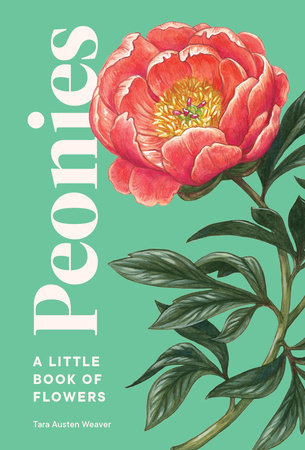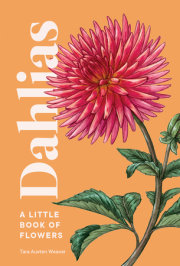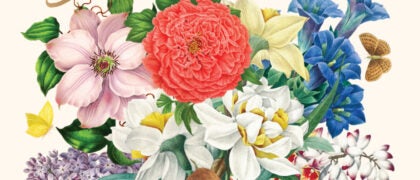Origin of the Species
"Had I but four square feet of ground at my disposal, I would
plant a peony in the corner and proceed to worship."
—ALICE HARDING,
THE BOOK OF THE PEONY Gardeners are a fanciful lot, prone to exaggeration and lyricism, but when it comes to the peony, it’s not a stretch to say she is the undisputed queen of the spring garden. Peonies are showstoppers, from the herbaceous (bush) peonies festooned with blossoms so multi-petaled they look
like pom-poms, to tree peonies studded with crinkled tissue paper–like blooms that seem improbably fragile, to the grace of a single stem set in a vase, flower petals changing color as they slowly unfurl. It’s no wonder that peonies have won hearts around the world.
With all this star power, you might expect peonies to be divas, requiring careful attention and lots of it, but they aren’t. Peonies are one of the least demanding flowers you can grow; they require little maintenance yet offer up a stunning display each spring, and do so for decades. I’ve never met a gardener who regretted planting a peony. The only regret I know is not having room for more.
When we say “peony,” we’re actually speaking of three different flower types. All peonies are perennials that lose their foliage in winter, but the genus can be divided into three types: herbaceous peonies that die back entirely, tree peonies that bloom on woody stems, and intersectional peonies that are a cross between the two. While intersectional peonies are relatively new—introduced in the 1960s—herbaceous and tree peonies have a history that goes back thousands of years.
Peonies are considered native to Asia, North America, and Europe, where their territory wraps around the Mediterranean. They thrive in climates that have cool winters—chill hours are required for them to properly develop flower buds. The genus Paeonia consists of about thirty species of flowering plants in the family Paeoniaceae. Within that group, however, is a wide variety—from large, showy blooms stuffed with petals that make their way into bridal bouquets and flower arrangements, to the simplicity of a five-petal flower, striking in its minimalism. It’s hard to believe that such diversity exists within a single genus.
While peony forms vary from simple to petal-stuffed and elaborate, the single peony form starts as a sepal-covered bud that swells to reveal a row of petals surrounding a mass of pollen-laden stamens with a carpel in the center. The carpel ends in the stigma, which is where the pollen must be deposited to enable fertilization.
The name peony comes to us from the Greeks. According to Greek mythology, Paeon was a student of Asclepius, the god of medicine. But Asclepius was a jealous teacher. When he saw Paeon using the peony root to heal Hades, god of the underworld, he grew angry. In order to protect Paeon from Asclepius’s anger, Hades transformed Paeon into a peony.
There are several versions of this myth. Another variation has Leto, goddess of fertility, telling Paeon about a root on the slopes of Mount Olympus that was helpful to women in labor. It shows that peonies have been valued for their medicinal use as much as for their beauty—and sometimes far more for the former. In both Europe and Asia, peony root has been used to treat a variety of ailments, from epilepsy, to hypertension, menstrual cramping, and spasms. In medieval Europe, peony was referred to as the “apothecaries’ flower,” for its wide health applications. In the British Isles, where peonies arrived in the 1200s, children used to wear necklaces made of beads carved from peony root to help with teething and to prevent seizures. Indeed, peony root is still used in Chinese medicine to this day. The flower’s earliest use and value was as a health aid. It would be much later that their blooms became as prized as their roots.
The peonies we plant in our garden today carry with them quite a history—from ancient China and Greece, carried in the bags of traders on horseback, in ships across oceans, and in the covered wagons of colonial settlers. Peonies have been through successive waves of popularity and fortune, revered by emperors, sought after by plant collectors, and tended by farmers, backyard gardeners, and painstaking breeders. These days they are beloved by florists and brides.
Peonies have long had associations with love and romance. According to garden writer Julie Martens Forney, “These lovely, luxurious blossoms have come to represent good fortune in marriage.” Apparently, roses were the flowers with which to woo a woman—but once he had won her affection, a man would give peonies to his intended bride. This helped secure a place for peonies in bridal bouquets that still continues today; they are thought to confer good fortune, prosperity, and a peaceful, happy marriage.
The peony is also connected to bashfulness and shame. This goes back to a different version of the peony myth from ancient Greece. One day, Aphrodite, goddess of love, found Apollo flirting with a pretty nymph, who hid in the petals of a peony flower to escape the wrath of the angry goddess. For the Victorians, who believed in a language of symbolism behind different flowers, the peony was emblematic of shame. According to
The Meaning of Flowers, by Claire Powell, “They are not blushes of modesty which suffuse it with its rosy hues, but the fiery cheeks of guilt, for this flower is the hiding place of a dishonourable nymph.”
Paper flower artist Chantal Larocque sums up what has made us love and seek out peonies throughout history—both their gloriousness and their fleeting nature, blooming for just a few weeks each spring. “In my mind, no other flower can compete with the perfection of the peony,” she writes. “The silky petals, delicate shape, romantic shades, and graceful foliage make this flower my all-time favorite, and I’m not alone. Brides plan their wedding dates around peony season. Flower enthusiasts plant them all through their gardens. Florists go crazy over all the different shades available . . . Sadly, this bloom can only be enjoyed in nature for a very short time each year.”
Peonies may be a brief annual affair, but as any enthusiast will tell you, it is always worth it.
Copyright © 2022 by Tara Austen Weaver. All rights reserved. No part of this excerpt may be reproduced or reprinted without permission in writing from the publisher.



























